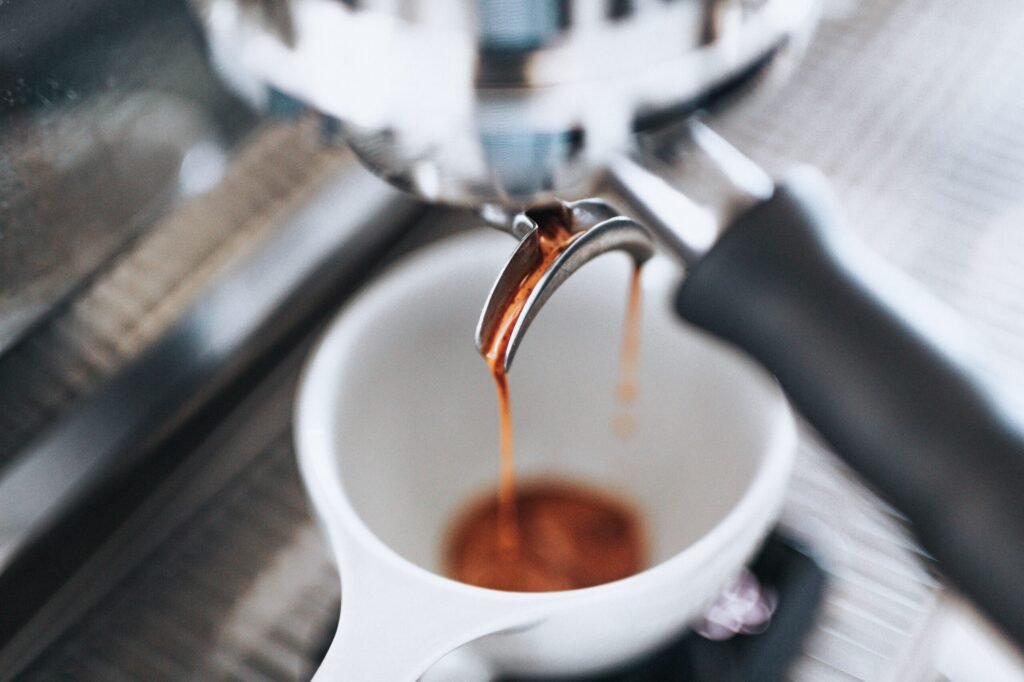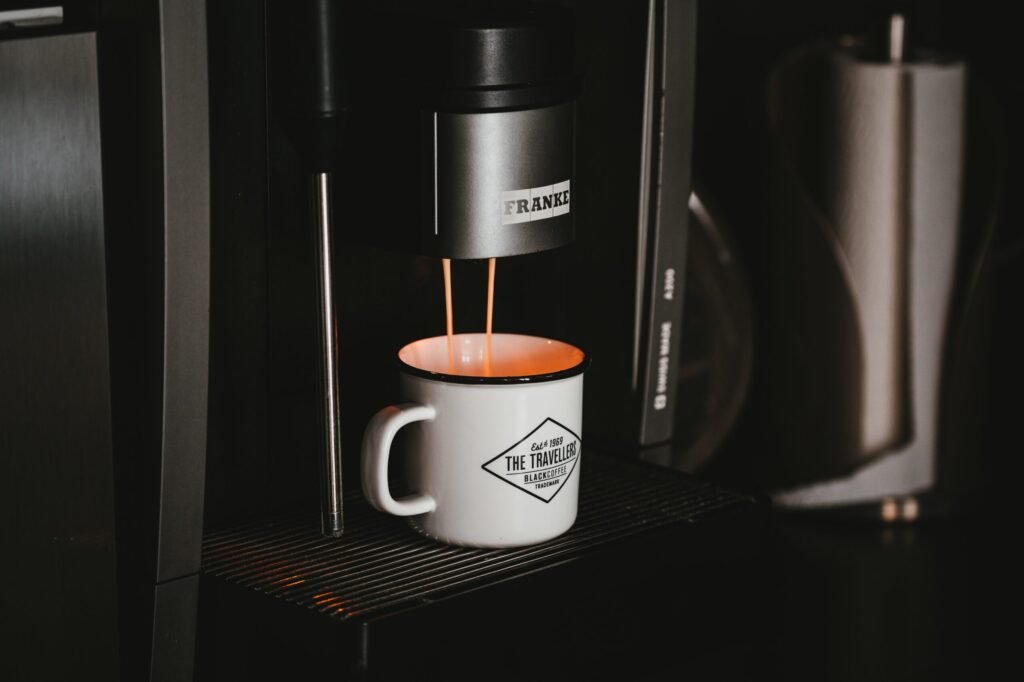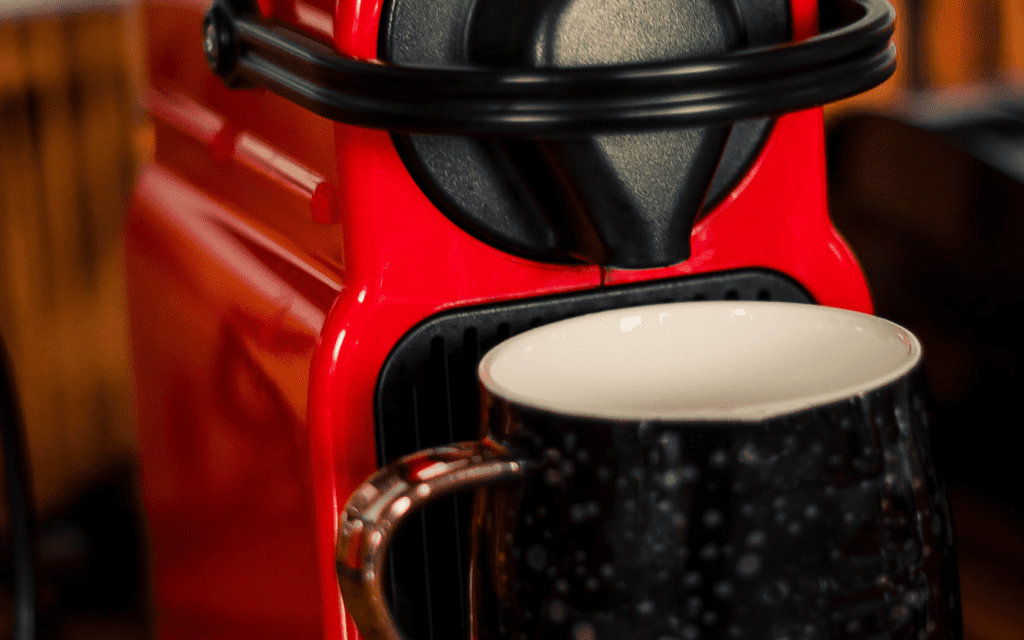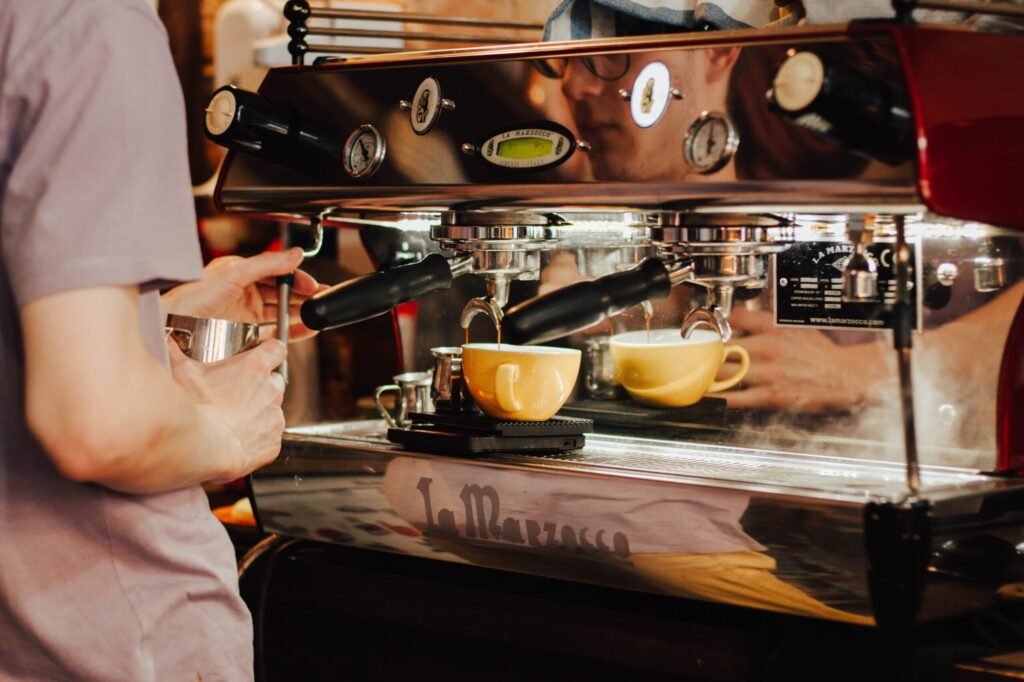ESPRESSO COFFEE MACHINE
An espresso coffee machine is a special tool that makes strong and tasty coffee called espresso. It works by pushing hot water through finely ground coffee beans with pressure. People use these machines a lot in cafes, restaurants, and homes to make different kinds of coffee drinks like cappuccino, latte, and mocha.
TYPES OF ESPRESSO MACHINES
Espresso is a strong and tasty coffee that people all around the world love. To make the best cup, you need the right espresso machine. There are different types of coffee machines with special features. In this guide, we’ll look at these machines to help you pick the one you like best.
1. MANUAL ESPRESSO MACHINES

Manual espresso machines, also called lever machines, are the old-school way of making coffee. They let skilled baristas have full control over how they make espresso. Although they might take some time to learn, the payoff is that you can create a special and personalized cup of espresso like no other.
HOW THEY WORK:
Manual espresso machines operate on a straightforward yet intricate mechanism. Instead of relying on automated processes, the barista takes charge of each step:
Grinding and Tamping: The first step involves grinding the coffee beans to a fine consistency. The barista then manually tamps the coffee grounds into the portafilter, ensuring a compact and even puck.
Water Delivery: Once the coffee grounds are prepared, a lever is used to initiate the water delivery process. The barista pulls the lever down, forcing hot water through the tamped coffee grounds.
Pressure Control: One of the defining features of manual espresso machines is the ability to control the pressure manually. The barista adjusts the lever to regulate the pressure applied to the coffee puck during extraction, influencing the flavor and characteristics of the resulting espresso shot.
Shot Timing: Timing is crucial in manual espresso machines. The barista determines when to lift the lever to stop the water flow, determining the length of the extraction. This step requires precision to achieve the desired flavor profile.
ADVANTAGES:
Artistic Control: Manual machines provide an artistic and hands-on experience, allowing the barista to showcase their skills and creativity.
Customization: With control over pressure, timing, and other variables, baristas can fine-tune the espresso to their liking.
Durability: Manual machines often have fewer components, making them robust and durable with proper maintenance.
CHALLENGES:
Learning Curve: Operating a manual machine requires a learning curve to master the skill of pulling consistent and high-quality shots.
Time-Consuming: The manual process can be time-consuming, making it less practical for those seeking quick and convenient espresso.
In simple terms, manual coffee machines are for people who love making coffee as a craft. You have a lot of control over how you make your coffee, which can make the whole experience more special and enjoyable. People who really love and appreciate the art of making coffee tend to prefer manual machines.
2. SEMI-AUTOMATIC ESPRESSO MACHINES

Semi-automatic espresso machines strike a balance between the control offered by manual machines and the convenience of fully automatic ones. These machines are popular among coffee enthusiasts who appreciate the hands-on experience of crafting espresso but also seek some level of automation to simplify the process.
HOW THEY WORK:
Semi-automatic espresso machines need you to be part of making your coffee. Here’s a simple explanation of how these machines work:
Grinding and Tamping: Start by picking and grinding the coffee beans to how you like it. This lets you adjust the grind size based on your taste and the type of coffee you’re using. After grinding, put the coffee grounds into the portafilter, a metal basket that holds the coffee. Use a tamper to press the grounds down, making a flat and even surface.
Inserting the Portafilter: The portafilter, now filled with tamped coffee grounds, is inserted into the machine’s group head – the part of the machine that holds the portafilter in place.
Initiating the Extraction: Unlike machines that work all by themselves, semi-automatic ones need you to start and stop the process yourself. You make the water flow by pressing a button or flipping a switch.
Inside the machine, a pump pushes hot water through the coffee grounds with force. This pressure helps bring out the flavors, oils, and smells from the coffee.
Monitoring the Extraction: During the extraction process, the barista can visually monitor the espresso flow. This allows for real-time adjustments, such as stopping the extraction when the desired volume is reached or adjusting the extraction time for flavor control.
End of Extraction: Once the desired amount of espresso is extracted, the user stops the water flow manually. This level of control is favored by those who want to tailor the strength and flavor profile of their espresso shots.
Semi-automatic espresso machines offer a satisfying middle ground for coffee enthusiasts who value both manual involvement and automated convenience. They provide the flexibility to experiment with various brewing parameters, making it possible to achieve a cup of espresso that suits individual taste preferences.
3. AUTOMATIC ESPRESSO MACHINES

Automatic espresso machines represent a middle ground between manual and fully automatic models. They strike a balance by offering users control over certain aspects of the coffee-making process while automating others for convenience. These machines are favored by those who seek a degree of customization without the hands-on involvement required by manual or semi-automatic machines.
HOW THEY WORK
The operation of automatic espresso machines is designed to simplify the brewing process for users. Here is a breakdown of how these machines typically work:
Grinding: Automatic espresso machines are equipped with built-in coffee grinders. Users add whole coffee beans to a hopper, and the machine grinds the beans to the desired coarseness just before brewing.
Tamping: Once the coffee is ground, the machine presses the coffee grounds into a tight puck automatically. Pressing the coffee evenly is really important to get a good flavor, and automatic machines make sure this step is done the same way every time.
Extraction: You can start and stop making coffee by pressing a button or flipping a switch. When you do that, hot water goes through the coffee grounds with a set pressure and time to bring out the tasty and aromatic parts.
Temperature Control: High-tech coffee machines precisely manage temperature to maintain consistent taste and enhance flavors from coffee grounds. Their advanced technology ensures the water temperature is optimal for a consistently delicious cup of coffee.
Pressure Regulation: These machines adjust the water pressure on their own while making coffee. This makes sure the coffee is brewed just right, creating the creamy layer on top and a tasty flavor.
Built-in Features: Lots of fancy coffee machines can do more than just make coffee. They have cool stuff like buttons you can press to set how much coffee you want, how hot it should be, and how strong. Some of them can even remember your favorite settings for next time.
Ease of Use: Automatic machines are easy to use, which is a big plus. You don’t have to be a skilled barista to operate them, making them great for people who want a good espresso without having to do it all manually.
ADVANTAGES
Consistency: Automatic machines provide a consistent and reliable brewing process, ensuring that each shot of espresso is of a uniform quality.
Convenience: Users enjoy the convenience of a semi-automated process without sacrificing control over crucial factors like grind size and shot duration.
Time-saving: The automation of grinding, tamping, and brewing reduces the time and effort required compared to manual or semi-automatic machines.
If you like espresso but want an easy way to make it just the way you like, automatic espresso machines are perfect. They’re convenient and let you customize your brew to suit your taste preferences, so you get a delicious cup with minimal effort.
4. SUPER-AUTOMATIC ESPRESSO MACHINES

Super-automatic espresso coffee machines that are super easy to use are like coffee magic. They do everything to make your espresso, from grinding the coffee beans to making frothy milk for different drinks. With one of these machines, you can enjoy lots of different coffee drinks without needing to be a coffee expert.
Super-automatic espresso machines have cool features that make them work well.
Grinding Mechanism: These machines have a built-in grinder for coffee. You don’t need a separate one. It grinds fresh coffee for each shot. You can change the grind settings to get the coffee size you like, which affects how the espresso tastes.
Brewing Process: The brewing process in super-automatic machines is fully automated. Users simply need to press a button to initiate the brewing cycle. The machine controls the water temperature, pressure, and flow rate, ensuring consistency and precision. This level of automation guarantees that every shot of espresso is brewed to perfection without requiring manual adjustments.
Programmable Settings: Super-automatic machines often come equipped with programmable settings, allowing users to customize various parameters. These settings may include coffee strength, water temperature, and the volume of the shot. This flexibility caters to individual taste preferences, ensuring that users can tailor their espresso experience to suit their liking.
Milk Frothing: Many super-automatic espresso machines include an integrated milk frothing system. This system can automatically steam and froth milk to create a rich and velvety foam for beverages like lattes and cappuccinos. Some machines may even offer multiple milk frothing options, allowing users to control the texture of the foam.
Cleaning and Maintenance: Keeping your coffee machine clean is easy with super-automatic machines. They usually clean themselves by rinsing the coffee and milk parts automatically. Some machines even have parts that you can take apart and clean easily for a hygienic brewing setup.
Touchscreen Interfaces: The user interface of super-automatic espresso machines is designed for simplicity and ease of use. Many models come with touchscreen displays or intuitive button controls, making it straightforward for users to navigate through the various settings and options.
Bean-to-Cup Capability: With a built-in grinder, super-automatic machines offer a true bean-to-cup experience. Users can load whole coffee beans into the machine, and the grinder will automatically grind the required amount for each shot. This ensures the freshest coffee flavor in every cup.
Cup Warming and Water Reservoir: Some super-automatic machines feature additional amenities such as cup warming trays to enhance the overall coffee-drinking experience. They also come equipped with sizable water reservoirs, reducing the frequency of refills and making these machines suitable for busy households or office environments.
Super-automatic espresso machines are a testament to the evolution of coffee technology, providing a hassle-free and consistent brewing experience. While they may come at a higher price point, the convenience and high-level automation they offer make them a popular choice for individuals who prioritize ease of use and want to enjoy a variety of espresso-based beverages without the need for extensive manual intervention.
5. POD OR CAPSULE ESPRESSO MACHINES

Pod or capsule espresso machines represent a convenient and user-friendly approach to brewing espresso. These machines have gained popularity for their simplicity, mess-free operation, and the consistent quality of coffee they produce. Here’s a detailed explanation of how pod or capsule espresso machines work and their key features:
HOW POD OR CAPSULE ESPRESSO MACHINES WORKS
Pods or Capsules: These machines use small, pre-packaged containers filled with coffee. These containers keep the coffee fresh and flavorful.
Loading the Machine: To make coffee, people put one of these containers into a special part of the machine. Some machines have separate spots for different types of drinks like espresso or lungo.
Brewing Process: Once the container is in place, the machine opens it up, letting hot water go through the coffee. The water is usually pressurized, like how espresso is made. The brewed coffee comes out through a spout and into the cup.
KEY FEATURES
Simplicity and Convenience: One of the main attractions of pod machines is their simplicity. Users don’t need to worry about grinding coffee beans, measuring grounds, or adjusting settings.The entire brewing process is streamlined, often requiring just the push of a button.
Consistency: Since the coffee is pre-measured and sealed in individual pods, there is a high level of consistency in flavor and strength with each use.This makes pod machines an attractive option for individuals who appreciate a reliable and predictable cup of coffee.
Mess-Free Operation: The use of sealed pods minimizes mess and cleanup. Users don’t have to deal with loose coffee grounds, making these machines a tidy and low-maintenance option.
Variety of Flavors: Many brands offer a wide variety of coffee blends, flavors, and intensities in pod or capsule form.Users can easily experiment with different options without the need to invest in various bags of coffee beans.
Limitations: While convenient, some coffee enthusiasts argue that the flavor and freshness of coffee from pods might not match that of freshly ground beans. Additionally, the cost per cup can be higher when compared to using traditional ground coffee.
MAINTENENCE:
Pod or capsule espresso machines generally require minimal maintenance. Regular tasks include emptying the used capsule container, descaling the machine periodically to remove mineral buildup, and ensuring the water reservoir is clean.
Pod or capsule espresso machines are an excellent choice for individuals seeking a hassle-free and consistent coffee experience. While they may not offer the same level of customization and authenticity as other types of espresso machines, their simplicity and convenience make them a popular option for busy lifestyles or those new to the world of espresso brewing.
6. COMMERCIAL ESPRESSO MACHINES

Commercial espresso machines are robust, high-performance coffee-making devices designed for the demands of busy establishments such as cafes, restaurants, and coffee shops. These machines are a testament to engineering precision and are equipped with features that ensure efficiency, consistency, and durability in a commercial setting.
KEY FEATURES
Multiple Group Heads: Commercial espresso machines often come with multiple group heads, which are the outlets where the coffee is dispensed. Each group head allows the barista to brew a separate shot of espresso. Machines can have anywhere from one to four or more group heads, enabling the preparation of multiple drinks simultaneously. This is crucial in high-traffic environments where efficiency is paramount.
High Capacity: These machines are made for making lots of coffee. They have big tanks for water and boilers to keep the water hot. This way, they can make espresso and steam milk all day without running out of hot water. Having a big capacity is important because it helps serve many customers without sacrificing the taste of the coffee.
Steam Wands and Hot Water Dispensers: To cater to a variety of coffee-based beverages, commercial espresso machines are equipped with powerful steam wands for frothing milk and hot water dispensers for teas or Americanos. These features enable baristas to create an extensive menu and provide a diverse range of hot beverages.
Programmability and Automation: Many commercial machines offer programmable features, allowing baristas to set parameters such as water temperature, shot volume, and extraction time. Automation helps maintain consistency in the brewing process, ensuring that every shot of espresso meets the establishment’s quality standards.
Durability and Build Quality: Given the rigorous demands of a commercial setting, these machines are constructed with durable materials such as stainless steel. The build is robust to withstand constant use and potential wear and tear. Regular maintenance is still crucial, but commercial machines are designed to handle the heavy workload with minimal downtime.
Pressure and Temperature Controls: Commercial espresso machines often have advanced pressure and temperature controls. These features are essential for achieving the precise conditions required for extracting the best flavors from coffee beans. Consistent pressure and temperature contribute to the quality and taste of the espresso.
TYPES OF COMMERCIAL MACHINES:
Traditional Espresso Machines: These are the classic, manual-operated machines with lever or semi-automatic controls. Baristas have full control over the brewing process, making them suitable for establishments where the craft of coffee making is emphasized.
Automatic and Super-Automatic Machines: Some commercial machines offer automatic and super-automatic features, streamlining the brewing process and minimizing the skill required. These are suitable for establishments with a high turnover and where consistent quality is essential.
Commercial espresso machines are the workhorses of the coffee industry, capable of delivering high-quality espresso consistently and efficiently. From traditional craftsmanship to advanced automation, these machines cater to a wide range of preferences within the dynamic and demanding environment of commercial coffee service.
THINGS TO THINK ABOUT WHEN PICKING AN ESPRESSO MACHINES
Budget: Espresso machines PRICE , depends on the brand, quality, features, and performance. Generally, the more expensive the machine, the more consistent and reliable it is, and the more control and customization it offers. However, there are also some affordable options that can produce decent espresso, especially for beginners or casual drinkers.
Skill level: Espresso machines can also vary in the level of skill and involvement they require from the user. Manual and semi-automatic machines are more suitable for experienced or enthusiastic users who enjoy the art and science of espresso making and want to have more control over the process. Fully and super-automatic machines are more convenient and easy to use, but they also limit the user’s ability to adjust the variables and experiment with different settings.
Space: Espresso machines come in different sizes for your kitchen. Some are small and stylish, while others are big and heavy. Before you buy one, make sure to measure your kitchen space and check how much room the machine needs.
Maintenance: Espresso machines need to be cleaned and taken care of regularly so they work well for a long time. Some machines can clean themselves, but others need you to clean them manually. Just follow the instructions from the company that made the machine, and use the right stuff to keep it in good shape.
BENEFITS OF HAVING AN ESPRESSO MACHINE
Espresso machines are awesome for making different coffee drinks at home or work. If you love really good coffee taste and quality, having an espresso machine can make your coffee experience rich and satisfying. Here are some reasons why having an espresso machine is great:
- Convenience: Espresso machines allow the user to make coffee anytime and anywhere, without having to go to a coffee shop or wait in line. The user can also customize the drink according to their preferences, such as the strength, temperature, and milk ratio.
- Savings: Espresso machines can help the user save money in the long run, as they can avoid spending on expensive coffee drinks from outside. The user can also use their own coffee beans or pods, which can be cheaper and fresher than pre-ground coffee.
- Quality: Espresso machines can produce high-quality coffee that has a rich aroma, flavor, and crema. The user can also choose the best coffee beans or pods that suit their taste and preferences, and grind them to the ideal fineness for optimal extraction.
- Variety: Espresso machines can enable the user to make different kinds of coffee drinks, such as espresso, cappuccino, latte, macchiato, and mocha. The user can also experiment with different ingredients, such as syrups, spices, and whipped cream, to create their own unique recipes.

